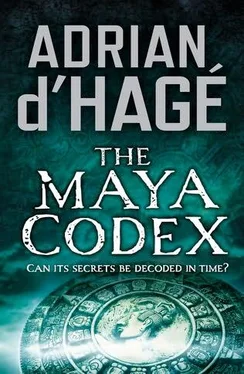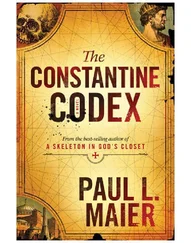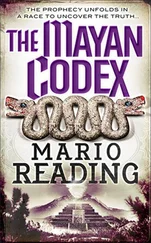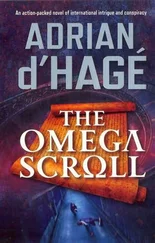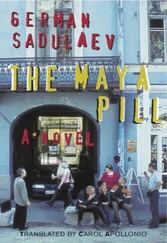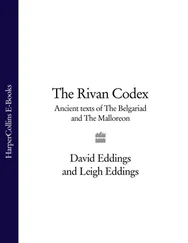Adrian D'Hage - The Maya codex
Здесь есть возможность читать онлайн «Adrian D'Hage - The Maya codex» весь текст электронной книги совершенно бесплатно (целиком полную версию без сокращений). В некоторых случаях можно слушать аудио, скачать через торрент в формате fb2 и присутствует краткое содержание. Жанр: Политический детектив, на английском языке. Описание произведения, (предисловие) а так же отзывы посетителей доступны на портале библиотеки ЛибКат.
- Название:The Maya codex
- Автор:
- Жанр:
- Год:неизвестен
- ISBN:нет данных
- Рейтинг книги:3 / 5. Голосов: 1
-
Избранное:Добавить в избранное
- Отзывы:
-
Ваша оценка:
- 60
- 1
- 2
- 3
- 4
- 5
The Maya codex: краткое содержание, описание и аннотация
Предлагаем к чтению аннотацию, описание, краткое содержание или предисловие (зависит от того, что написал сам автор книги «The Maya codex»). Если вы не нашли необходимую информацию о книге — напишите в комментариях, мы постараемся отыскать её.
The Maya codex — читать онлайн бесплатно полную книгу (весь текст) целиком
Ниже представлен текст книги, разбитый по страницам. Система сохранения места последней прочитанной страницы, позволяет с удобством читать онлайн бесплатно книгу «The Maya codex», без необходимости каждый раз заново искать на чём Вы остановились. Поставьте закладку, и сможете в любой момент перейти на страницу, на которой закончили чтение.
Интервал:
Закладка:
The cam turned easily and O’Connor quietly swung the steel door open. Climbing to the second floor, he was again confronted with a pin-and-tumbler lock. At his first attempt, the lock didn’t open. O’Connor delved into his soft leather briefcase and selected a pick with a finer head. Top student of more than one of the CIA’s training courses, O’Connor fleetingly thought of the old master safecracker who’d been recruited from the dark side to teach CIA officers the art of break and enter. To the south-east of Richmond, Virginia, on Rochambeau Drive, was a place listed as the Camp Peary Naval Reservation. In fact, it was one of several top-secret CIA training bases where O’Connor had spent many hours honing the shadowy crafts of his profession. As he applied just enough pressure to hold the rear pins over the shear line, he carefully felt for the final pin and eased it up over the ledge he’d created with the torsion wrench.
O’Connor closed the solid cedar door quietly behind him. A short hallway led into the lounge room, which overlooked Sterngasse and Judengasse. To the left another corridor led past the spacious kitchen to the bedrooms and the bathroom at the far end. He looked around the lounge room. Soft white wool carpets and gold-and-black velvet drapes complemented the rococo Louis XV furniture. The walls were lined with mahogany bookcases, and O’Connor quickly ran his eye over the contents. Given Weizman’s background, it was not surprising to find whole shelves devoted to archaeology, and in particular to the Maya. There were works by the legendary Alfred Maudslay, who in the late nineteenth century opened up the ancient Mayan civilisation to more modern research; as well as publications by J E S Thompson on Maya Arithmetic and The Solar Year of the Mayas. Other shelves were devoted to works by Newton, Einstein, Erwin Schrodinger and Max Planck, the latter three inscribed by the famous authors to Professor Levi Weizman. O’Connor whistled softly as he recalled his earlier years at Trinity College in Dublin, where he’d wrestled with Schrodinger’s equations that described fiendishly difficult issues in quantum mechanics, like the movement of an electron around an atom. Levi Weizman had obviously rubbed shoulders with some of the finest scientists the world had seen.
The spacious apartment had three bedrooms, one of which was again lined from floor to ceiling with books. O’Connor tried the large wall safe, but it was locked. It would take time to crack it, so he left it for the moment and turned his attention to the main bedroom. He carefully went through it, but found nothing to explain Washington’s interest. He picked up a folder entitled Bad Arolsen Records from the bedside table and flicked through it. In 2006 the German government had finally agreed to release the Nazi records on seventeen million people who had been imprisoned, tortured or murdered at the hands of the Third Reich. Two books were also on the bedside table, The Popol Vuh, the sacred book of the ancient Quiche Maya, one of the most powerful Mayan tribes of the Guatemalan highlands, and The Hidden Maya Code by Monsignor Matthias Jennings. O’Connor surmised that Weizman might be attending Jennings’ lecture. He replaced the book exactly where he’d found it and headed for the bathroom.
O’Connor opened the bathroom cabinet. Amongst Aleta’s personal toiletries there was a single bottle of medication labelled ‘Sarafem’, half-full of purple-pink capsules. He examined the capsules and compared them to the wide range of pills in different colours, shapes and sizes in his briefcase. He wondered why Aleta might have been prescribed fluoxetine, otherwise known as Prozac, and then as Sarafem for women. Might Aleta be taking it for a severe form of premenstrual syndrome? Or could she be clinically depressed? The latter might be more likely, he thought, although with the administration at 1600 Pennsylvania Avenue wanting her head on a plate, Weizman’s medical issues were perhaps the least of her problems.
O’Connor selected a sachet from his briefcase and chose an identical pill to those in Dr Weizman’s bottle, a pill the boys back in Science and Technology at Langley had dubbed ‘aspirin roulette’. The purple capsule contained a massive dose of morphine, equivalent to 200 milligrams of heroin, more than twice the dose required to kill even severe addicts with high resistance. The Polizei would find morphine in her bloodstream and the media would speculate, but with a lack of motive and the absence of any other poisoned pills in the bottle, the Polizei would suspect she was on drugs, the media would lose interest and the coroner would be forced to reach an open finding.
O’Connor paused as he recalled his conversation with Wiley back at Langley: ‘Find out everything there is to know about this Weizman bitch, and then silence her!’ Again the question demanded an answer… why? ‘You’re skating on fucking thin ice, O’Connor.’
For the first time in a long career, Curtis O’Connor disobeyed an order that had been put to him as a ‘clear and present danger’, an order that only the President could approve. O’Connor doubted the President had any idea of what the Vice President, Wiley or the hotheads in the Pentagon were up to. He put the aspirin roulette pill back into the sachet in his briefcase. The CIA was not the same agency he’d joined nearly twenty years before; and not until he worked out why Washington wanted this woman dead would he comply.
26
T he Prefect of the Congregation for the Doctrine of the Faith, Cardinal Salvatore Felici, was working at his huge desk in his opulent office in the Palazzo della Sacra Inquisizione. A forbidding grey-and-ochre palace, it still went by the name of the Sacred Inquisition. Felici’s father, Alberto, had been a trusted advisor to Pope Pius XII and the cardinal was carrying on in his family’s tradition of service to the Holy Church.
Tall and powerfully built, Cardinal Felici was proud of his good head of fine black hair, flecked with grey and combed straight back under his scarlet zucchetto, the distinctive skull cap of the College of Cardinals. He had a long rectangular face, and a large aquiline nose. His piercing grey eyes were hooded, underscored by dark circles, but, like a peregrine falcon, Salvatore Felici missed nothing. His anger rose as he again scrutinised an article by the Guatemalan archaeologist, Dr Weizman, dutifully forwarded to his office by the papal nuncio in Guatemala City. Felici’s red pen was poised to strike as he absorbed her assertions on the existence of a lost codex, and tried to decipher the intermeshing glyphs on Aleta’s diagram of the Mayan calendars: Unlike our own linear calendars, the Mayan calendars, as the diagram shows, measured time in short and long cycles which enabled them to accurately predict major recurring events. The Mayan short- and long-count calendars intermeshed like gears in a gearbox. The larger wheel, the Haab, was based on cycles of the earth, using eighteen months with twenty days in a month giving 360 days. A short nineteenth month consisted of the extra five days, totalling 365. The smaller gear, the sacred Tzolk’in, was based on the cycles of the Pleiades star cluster in the constellation Taurus, so prominent in the night skies of planet earth. The twenty-first of December 2012 heralds a rare once-in-26 000 years meshing of calendar gears that can predict four days, 4000 or 40 000 days in advance. We are living in the Mayan end times, an end time that is dictated precisely by the movement of the planets. The great 26000-year cycle, or 25625 years to be precise, consists of five smaller cycles, each 5125 years in length, and the Maya discovered that our sun, which they called Kinich-Ahau, synchronises with the centre of our galaxy once in each of the smaller cycles. There is an abundance of evidence that proves the accuracy of Mayan predictions. Over a thousand years before it occurred, the Maya predicted the solar eclipse on 11 August 1999 down to the last second – 11:03:07 universal coordinated time – an eclipse that was the most watched in history and the first visible in the United Kingdom since
Читать дальшеИнтервал:
Закладка:
Похожие книги на «The Maya codex»
Представляем Вашему вниманию похожие книги на «The Maya codex» списком для выбора. Мы отобрали схожую по названию и смыслу литературу в надежде предоставить читателям больше вариантов отыскать новые, интересные, ещё непрочитанные произведения.
Обсуждение, отзывы о книге «The Maya codex» и просто собственные мнения читателей. Оставьте ваши комментарии, напишите, что Вы думаете о произведении, его смысле или главных героях. Укажите что конкретно понравилось, а что нет, и почему Вы так считаете.
